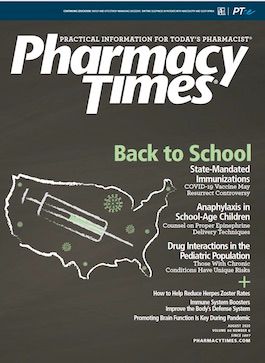Publication
Article
Pharmacy Times
Understanding the Beers Criteria Is Essential
Author(s):
This medication list helps screen for and assess potentially inappropriate drugs to prevent adverse effects, hospitalization, and even death.
Even when prescribed in appropriate doses and for the right conditions, medications can increase the risk for death.
As counterintuitive as this may seem, decades of data demonstrate that when patients take multiple medications for multiple conditions, also known as polypharmacy, their odds of adverse effects, hospitalizations, and even death are significantly greater.1 This is because when medications are studied for efficacy and safety, they are often studied in individuals taking few other medications and with few other chronic diseases. Unfortunately, this does not match the typical patient population, and as a result many patients are at risk of these adverse consequences of polypharmacy. In fact, more than two-thirds of Americans use 3 or more medications each month.2 Fortunately, pharmacists and pharmacy technicians can combat this hidden epidemic in their pharmacies.
CASE STUDY
Erica is a tech with a national pharmacy chain. She has been asked to begin promoting medication therapy management (MTM) for patients at the pharmacy to help patients feel better, save money, and take fewer medications. A few weeks after a scheduled MTM session, the daughter of a pharmacy patient comes in, asks for Erica’s hand, shakes it, and says, “You saved my mother’s life.” She tells Erica that the MTM session took her mother from “nonfunctional” and preparing to be moved into a nursing home to being able to go out and about again.
HUNTING FOR MEDICATION HARMS
How did this happen? Was it a fluke or too good to be true? This real-life story, captured in a recent study published in the Journal of the American Pharmacists Association, describes a phenomenon common in elderly patients.3 Underlying this patient’s “nonfunctional” status was polypharmacy, additive adverse effects from medications that made the patient appear to be experiencing cognitive decline similar to dementia. Fortunately, thanks to services like MTM, pharmacists are able to proactively search for medications that are most likely to lead to serious iatrogenic adverse effects, hospitalizations, and death related to polypharmacy. One of the most popular tools that pharmacists have used for about 30 years is the Beers Criteria medication list.
The list was introduced in 1991 to improve the quality of care for older adults.4 It is named after the geriatrician Mark H. Beers, MD, who worked with a panel of experts to develop a list of potentially inappropriate medications (PIMs) in older adults in the early 1990s. Last updated in 2019, the list includes both the PIMs and corresponding expert recommendations on how to handle each PIM based primarily on expert consensus, although not necessarily on published evidence. For this reason, each of the recommendations on the list is accompanied by a ranking of the quality of evidence that supports the expert opinion. This is important, as the list should be applied individually to each patient based on their medication profile and symptoms, not as an absolute list of “bad” and “good” drugs, because in the vast majority of cases there are no large-scale, randomized trials to support these expert opinions.
The most recent version of the Beers Criteria includes 30 medications or medication classes that most older individuals should avoid and 40 medications or medication classes that they should use with caution.5 The full list, educational resources, supporting documents, and tools are available on the American Geriatrics Society website.6 In releasing the most recent version of the list, the expert panel reiterated the need for health care professionals to use it to guide clinical decision making and conversations with patients. In other words, the list is simply a starting point for pharmacists to create safer medication regimens. Because the Beers Criteria is not a universal list of inappropriate medications but rather only potentially inappropriate ones, such special guidance for payers, pharmacists, prescribers, and policymakers is important.
Also new in the 2019 version is specific guidance on the use of the list in quality measures. In pharmacy, quality measures are data collected from prescription insurance claims data that help quantify pharmacy processes and patient outcomes associated with high-quality care.7 Traditionally, pharmacy professionals have used the list on an individual basis during face-to-face patient appointments, such as MTM sessions. However, the criteria could also be used on a mass scale to treat a large group of patients with screening algorithms that alert the pharmacist, techs, or other health care workers to a potentially inappropriate medication, similar to a drug utilization review screen. Payers, such as Medicare, are interested in the Beers Criteria for better treatment of patients in order to improve care quality and reduce health care costs. This is often seen in the community pharmacy as standalone platforms such as EQuIPP (Electronic Quality Improvement Platform for Plans and Pharmacies) or built into the pharmacy dispensing software itself, appearing as an alert or flag during medication dispensing.
The tech may come across the Beers Criteria list used as a standalone document or applied generally to the entire pharmacy patient population within the dispensing software used by the pharmacy. In either case, there are a few important points to keep in mind about its use:
- The list is a “warning light” not a stop sign and should be used in combination with patient-reported symptoms to judge the potential risk.
- All drugs are a balance of benefit and effect, and no drug is absolutely bad or absolutely good for a patient.
- Ideally, health care professionals use the list as expert, quick guidance when they are unsure whether a drug is potentially inappropriate and need to know how to proceed with assessing the patient and planning for next steps.
- The list should be employed as an educational tool to guide patient conversations about potentially harmful medications so that a shared decision can be made.
CONCLUSION
Techs are increasingly relied on to support the clinical services that pharmacists provide, including MTM. Using polypharmacy tools, such as the Beers Criteria list, to screen for and assess potentially inappropriate medications is a good first step in preventing unintended iatrogenic adverse effects, hospitalizations, and death. However, such tools need to be balanced with patient-specific factors, such as age, fragility, overall health, and weight, and decisions should be guided by both the patient and pharmacist, as there is no one-size-fits-all approach to dealing with polypharmacy.
Kenneth C. Hohmeier, PharmD, is an associate professor of clinical pharmacy and translational science and director of community affairs at the University of Tennessee Health Science Center in Nashville.
REFERENCES
- Leelakanok N, Holcombe AL, Lund BC, Gu X, Schweizer ML. Association between polypharmacy and death: a systematic review and meta-analysis. J Am Pharm Assoc. 2017;57(6):729-738.e10. doi:10.1016/j.japh.2017.06.002
- Table 79. Prescription drug use in the past 30 days, by sex, race and Hispanic origin, and age: United States, selected years 1988-1994 through 2011-2014. Centers for Disease Control and Prevention. 2017. Accessed July 28, 2020. https://www.cdc.gov/nchs/data/hus/2017/079.pdf
- Hohmeier KC, McDonough SLK, Rein LJ, Brookhart AL, Gibson ML, Powers MF. Exploring the expanded role of the pharmacy technician in medication therapy management service implementation in the community pharmacy. J Am Pharm Assoc. 2019;59(2):187-194. doi:10.1016/j.japh.2018.11.006
- Beers MH, Ouslander JG, Rollingher I, Reuben DB, Brooks J, Beck JC. Explicit criteria for determining inappropriate medication use in nursing home residents. UCLA Division of Geriatric Medicine. Arch Intern Med. 1991;151(9):1825-1832. doi:10.1001/archinte.1991.00400090107019
- 2019 American Geriatrics Society Beers Criteria Update Expert Panel. American Geriatrics Society 2019 updated AGS Beers Criteria for potentially inappropriate medication use in older adults. J Am Geriatr Soc. 2019;67(4):674-694. doi:10.1111/jgs.15767
- American Geriatrics Society updated Beers Criteria for potentially inappropriate medication use in older adults. GeriatricsCareOnline.org. 2019. Accessed July 28, 2020. https://geriatricscareonline.org/ProductAbstract/american-geriatrics-society-updated-beers-criteria-for-potentially-inappropriate-medication-use-in-older-adults/CL001
- Quality measures. Centers for Medicare & Medicaid Services. Updated February 11, 2020. Accessed July 28, 2020. https://www.cms.gov/Medicare/Quality-Initiatives-Patient-Assessment-Instruments/QualityMeasures







